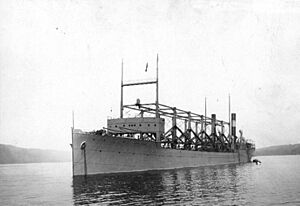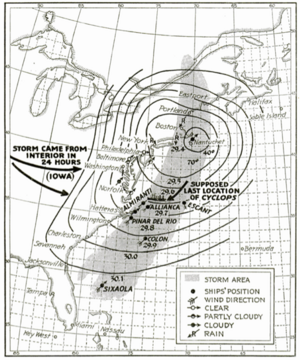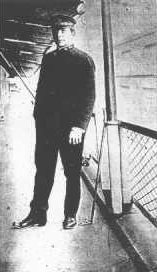USS Cyclops facts for kids

USS Cyclops on the Hudson River in 1911
|
|
| History | |
|---|---|
| Name | Cyclops |
| Namesake | Cyclops |
| Builder | William Cramp & Sons, Philadelphia |
| Yard number | 355 |
| Launched | 7 May 1910 |
| Commissioned | 1 May 1917 |
| Fate | Lost at sea, March 1918 |
| General characteristics | |
| Class and type | Proteus-class collier |
| Displacement | 19,360 long tons (19,671 t) full |
| Length | 542 ft (165 m) |
| Beam | 65 ft (20 m) |
| Draft | 27 ft 8 in (8.43 m) |
| Propulsion |
|
| Speed | 15 kn (28 km/h; 17 mph) |
| Capacity |
|
| Complement | 236 officers and enlisted |
| Armament | 4 × 4 in (100 mm) guns |
The USS Cyclops (AC-4) was a large ship built for the United States Navy before World War I. It was one of four ships in its class, designed to carry coal to other naval vessels. The ship was named after the Cyclops, mythical giants from Greek mythology. The USS Cyclops became famous for its mysterious disappearance in March 1918, along with all 306 people on board. No trace of the ship or its crew was ever found, making it one of the biggest mysteries in U.S. Navy history.
Contents
The Story of the USS Cyclops
The Cyclops was launched on May 7, 1910, in Philadelphia. It began its service on November 7, 1910. For several years, it traveled to places like the Baltic Sea and the Caribbean, delivering coal to Navy ships. It even helped during the United States occupation of Veracruz in Mexico in 1914-1915, assisting in moving people to safety.
When the United States joined World War I, the Cyclops was officially put into military service on May 1, 1917. It sailed to France and then mostly served along the East Coast of the U.S. In early 1918, it was sent to Brazil to refuel British ships.
The Mysterious Disappearance
The Cyclops left Rio de Janeiro, Brazil, on February 16, 1918. It made a stop in Salvador, Bahia and then departed for Baltimore, Maryland, on February 22. The ship was carrying a very heavy load of manganese ore, which is used to make weapons. Some people thought the ship might have been overloaded. Before leaving Brazil, the captain reported that one of the ship's engines was damaged.
The ship made an unexpected stop in Barbados. There were concerns that the ship was too low in the water, suggesting it was carrying too much weight. After leaving Barbados on March 4, the Cyclops was never seen again. It was supposed to arrive in Baltimore around March 13. No wreckage or signs of the ship or its crew have ever been found.
What Happened Next?
The Navy announced the Cyclops was missing on April 15, 1918. On June 1, 1918, Franklin D. Roosevelt, who was Assistant Secretary of the Navy at the time, declared the ship and everyone on board officially lost. The loss of the Cyclops was a major event during World War I.
One of the people lost on the Cyclops was Lewis H. Hardwick. He was the father of Herbert Lewis Hardwick, a famous boxer known as "The Cocoa Kid."
Possible Reasons for the Loss

Many ideas have been suggested about what happened to the Cyclops.
- Enemy Attack: Since it was wartime, some thought a German submarine or warship might have sunk or captured it. However, German authorities said they had no knowledge of the ship.
- Bad Weather: Reports show a strong storm hit the area where the Cyclops might have been around March 10. Some experts believe the ship, possibly overloaded and with engine trouble, could have sunk in the storm.
- Structural Problems: The Cyclops had three sister ships, and two of them also disappeared mysteriously years later while carrying heavy loads of ore. This led to a theory that these ships might have had a weakness in their structure. The heavy ore could have shifted or caused too much strain, especially in rough seas.
- The Bermuda Triangle: Some people believe the Cyclops disappeared in the famous Bermuda Triangle, an area known for unexplained disappearances of ships and planes.
Experts from Lloyd's of London also looked into the mystery. They suggested that manganese ore, being very dense, could shift inside the ship's cargo holds, especially if it got wet and turned into a slurry. This shifting cargo, combined with only one working engine and bad weather, could have caused the ship to capsize or sink.
About the Captain
The captain of the Cyclops was Lieutenant Commander George W. Worley. He was born in Germany in 1862 as Johan Frederick Wichmann. He later changed his name to Worley. He was an experienced sailor and had commanded other ships before joining the Navy.
However, there were concerns about Captain Worley's leadership style. Some crew members reported that he was very strict and difficult to work with. There were also worries about his loyalty during wartime because he had many friends and associates who were German or of German descent.
Naval investigators also looked into how the ship was loaded. Captain Worley sometimes had less experienced officers oversee the loading of cargo. In Rio de Janeiro, a less experienced officer was in charge of loading the heavy manganese ore. This might have led to the ship being overloaded, which could have contributed to its sinking.
The U.S. consul in Barbados, Charles Ludlow Livingston, sent a telegram with his concerns. He mentioned that the captain seemed secretive and that the ship's engines were in poor condition. He also noted that many people with German names were on board. Livingston expressed a feeling that something worse than a simple sinking might have happened, possibly related to the captain.
The Cyclops' Sister Ships
The Cyclops had three sister ships, all built around the same time. Their stories are also quite interesting:
- USS Jupiter (AC-3) was later converted into the first American aircraft carrier, the USS Langley (CV-1). The Langley was very important for developing naval aviation. Sadly, it was attacked by Japanese aircraft and sunk in 1942 during World War II.
- USS Proteus (AC-9) was sold in 1941 and later disappeared at sea without a trace, likely in the Caribbean Sea, while carrying a heavy load of ore.
- USS Nereus (AC-10) was also sold in 1941 and vanished without a trace after leaving Saint Thomas, U.S. Virgin Islands, also carrying a heavy load of ore.
The similar disappearances of Proteus and Nereus years later, while carrying similar heavy cargo, made the mystery of the Cyclops even deeper.
The Cyclops in Books and TV
The mysterious story of the USS Cyclops has inspired many fictional works:
- In Clive Cussler's 1986 novel Cyclops, the adventurer Dirk Pitt finds the wreck of the ship.
- An episode of the TV show Quantum Leap called "Ghost Ship" features a character who claims to have been rescued by the Cyclops before its disappearance.
- The 2019 video game The Sinking City has a main character who served on the Cyclops and was the only survivor of its sinking, which is linked to strange, otherworldly events.
- The 2005 TV miniseries The Triangle shows a team discovering the sunken wreck of the Cyclops in the Bermuda Triangle.
- The 2006 animated movie Scooby-Doo! Pirates Ahoy! also features the Cyclops as the main characters enter the Bermuda Triangle, suggesting a supernatural link to its disappearance.
See Also
- List of missing ships


